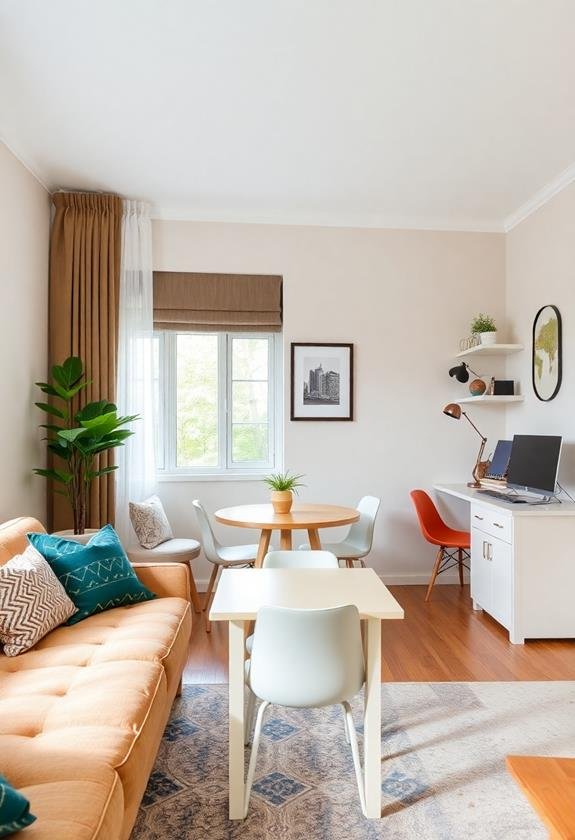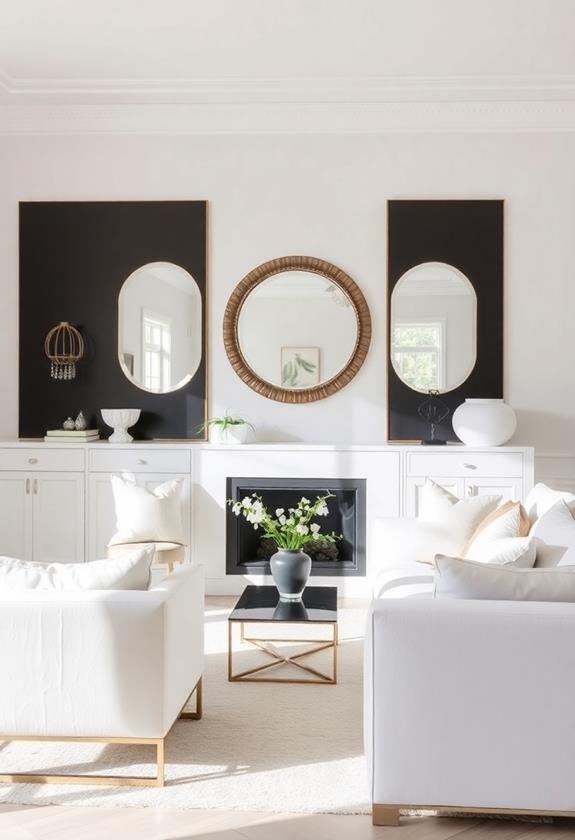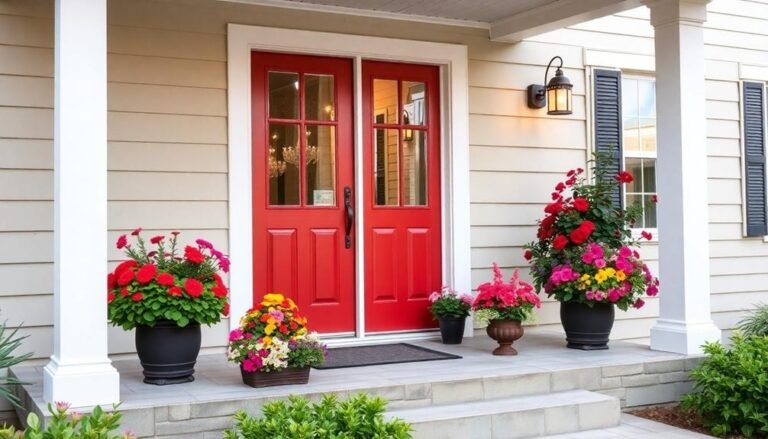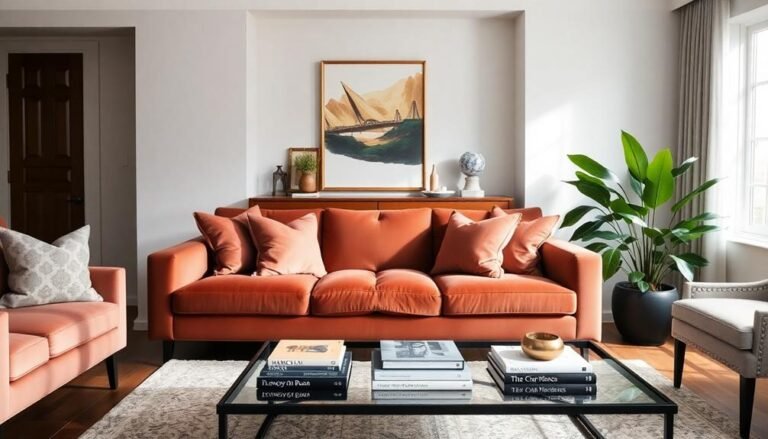To decorate an empty space for staging success, start by evaluating its potential. Arrange neutral-toned furniture to create functional zones, like cozy reading nooks or inviting dining areas. Use decorative accessories, such as throw pillows and live plants, to add character without overwhelming the space. Maximizing natural light is essential; position mirrors to reflect brightness and amplify the room's feel. Highlight unique architectural features with strategically placed lighting for an inviting atmosphere. By combining these elements, you cater to varied tastes and captivate potential buyers. For more tips on effective staging, you'll find valuable insights just ahead.
Assess the Space's Potential

Evaluating a space's potential is essential for successful staging. When you step into a room, take a moment to observe its layout, lighting, and flow. These elements can considerably influence how potential buyers perceive the space. Consider incorporating biophilic design elements, such as greenery or natural materials, to enhance the room's serenity. Ask yourself how each area can be best utilized. For instance, if you notice an awkward corner, consider how you might transform it into a cozy reading nook with a small chair and a bookshelf. This simple change can make the room feel more inviting.
Next, pay attention to the natural light. Bright, well-lit spaces often create a positive impression. If a room feels dark, think about rearranging furniture to maximize light or even adding mirrors to reflect it. Keep in mind that the overall layout should promote easy movement, making it easier for visitors to imagine themselves living there.
Lastly, take notes on any unique architectural features. You'll want to highlight these in your staging. By evaluating a space's potential and making thoughtful adjustments, you can create an environment that captivates prospective buyers, allowing them to envision their future in the home. Remember, every detail matters in making a lasting impression.
Choose a Neutral Color Palette

When it comes to staging a home, selecting a neutral color palette can greatly impact the overall appeal. Neutral colors create a calm and inviting atmosphere, making it easier for potential buyers to envision themselves in the space. By opting for shades like beige, gray, or soft white, you allow architectural features and furnishings to stand out while keeping the environment versatile. Additionally, incorporating trending decor items such as Positive Little Reminders Desk Wood Plaque Sign can enhance the inviting feel of the space without overwhelming the neutral backdrop.
Here are four key benefits of using a neutral color palette:
- Wider Appeal: Neutral colors attract a larger audience, as they cater to various tastes and preferences.
- Enhanced Space Perception: Light and airy shades can make rooms feel more spacious and open, which is particularly important in smaller areas.
- Easier Coordination: With a neutral base, you can mix and match décor items like artwork and accessories without clashing colors.
- Timelessness: Neutral tones tend to remain stylish over time, avoiding the risk of quickly becoming outdated or off-putting.
Utilize Versatile Furniture

Versatile furniture can make a significant difference in staging your home effectively. When you choose pieces that serve multiple purposes, you not only save space but also create an inviting atmosphere that potential buyers can envision themselves in. For instance, a sleek sofa bed can transform a living room into a cozy guest space, showcasing how the area can adapt to different needs. Incorporating budget-friendly decor options like stylish storage ottomans or nesting tables can further enhance the functionality of your space while keeping costs low.
Consider using items like nesting tables, which can be arranged in various configurations, or ottomans that offer both seating and storage. These kinds of furniture allow you to demonstrate the functionality of each space without overcrowding it. You might also think about a dining table that can extend to accommodate larger gatherings, giving buyers a glimpse of entertaining possibilities.
In addition, choose neutral colors for your versatile furniture to appeal to a wider audience. This way, it complements various styles, making the home feel warm and welcoming. Remember, the goal is to create an environment where potential buyers can picture their lives unfolding, so invest in furniture that not only looks good but also enhances the overall flow of your space.
Incorporate Decorative Accessories

Decorative accessories play an essential role in staging your home, as they add personality and charm to each room. These finishing touches can transform a bland space into a welcoming environment, making it easier for potential buyers to envision themselves living there. When choosing accessories, reflect on how they can enhance your home's features without overwhelming them.
Here are four key decorative accessories to contemplate incorporating:
- Throw Pillows: These can add color and texture to sofas or chairs, creating an inviting atmosphere. Opt for neutral tones with a pop of color to maintain appeal.
- Artwork: Select pieces that resonate with the style of your home. A well-placed painting or print can serve as a focal point and spark conversation.
- Plants: Live plants infuse life and freshness into a space. Choose low-maintenance varieties that thrive indoors, like succulents or snake plants.
- Mirrors: They can make a room feel larger and brighter. Hang a strategically placed mirror to reflect light and create the illusion of more space.
Highlight Key Features

In staging your home, it's important to not only add decorative accessories but also to emphasize the key features that make your property unique. By highlighting these elements, you can create a lasting impression on potential buyers. Start by identifying the standout characteristics of your home, such as architectural details, spacious rooms, or beautiful views.
Once you've pinpointed these features, arrange your furniture and decor to draw attention to them. For instance, if you have a stunning fireplace, consider positioning seating around it to create a cozy focal point. Utilize lighting strategically, too; a well-placed lamp can spotlight an artwork or an elegant feature, making it more inviting.
Don't forget about colors and textures; soft hues can enhance a room's brightness, while rich textures add depth. You might even use mirrors to reflect natural light or views, effectively widening the space visually.
Create Functional Zones

Creating functional zones in your home is essential for showcasing how each space can be used effectively. This helps potential buyers envision their lives within the property. To achieve this, consider the following tips for defining and enhancing each area:
- Living Room: Arrange seating to encourage conversation, adding a coffee table to create a central gathering spot. Use decorative pillows and throws for a cozy vibe.
- Dining Area: Set a beautifully dressed table with place settings and centerpieces. This not only highlights the space but also evokes a sense of hospitality.
- Home Office: Incorporate a desk, comfortable chair, and some organizational items. A functional workspace signals productivity and allows buyers to see its potential.
- Reading Nook: Add a comfortable chair, a small side table, and a lamp. This creates an inviting corner for relaxation, emphasizing the versatility of the space.
Use Mirrors to Enhance Light

Mirrors can transform a space by reflecting light and making rooms feel larger and more inviting. When staging a home, consider placing mirrors strategically to amplify natural light, especially in darker corners or smaller rooms. For instance, positioning a large mirror opposite a window can bounce sunlight around the room, creating a brighter atmosphere.
You'll want to choose mirrors with interesting frames that complement your overall décor. A decorative, vintage mirror can add character, while a sleek, modern design might enhance a contemporary aesthetic. Don't hesitate to mix sizes and shapes, as this can create visual interest, drawing the eye and making the space feel dynamic.
Additionally, consider the height at which you hang your mirrors. Ideally, they should be at eye level to be most effective, allowing for optimum reflection. If you're dealing with a narrow hallway, a long, vertical mirror can make the area appear more spacious.
Add Greenery and Natural Elements

To create a welcoming atmosphere, incorporating greenery and natural elements into your staging can make a significant difference. Plants not only add life to a space but also evoke feelings of calm and comfort. When potential buyers walk in, they should feel an immediate connection to the environment. Here are four easy ways to incorporate greenery and natural elements:
- Potted Plants: Use a variety of potted plants in different sizes to create visual interest. Consider low-maintenance options like snake plants or pothos, which thrive indoors.
- Fresh Flowers: Place fresh flowers in a tasteful vase on tables or countertops. A simple bouquet can brighten up any room and brings a touch of color.
- Natural Textiles: Incorporate textiles made from natural fibers, like cotton, linen, or jute. These materials can soften the space and create a cozy vibe.
- Wooden Accents: Add wooden elements, such as shelves or furniture, to introduce warmth and an organic feel. Reclaimed wood can be especially appealing, as it tells a story.
Capture the Right Lighting

Getting the lighting just right can transform your staged home and make it feel more inviting. Natural light is your best friend, so consider opening curtains and blinds during showings to let the sunshine in. If a room lacks windows or natural light, don't worry; you can create a warm atmosphere with strategically placed lamps. For instance, use floor lamps to brighten up corners or table lamps to add a cozy touch on side tables.
When choosing light bulbs, opt for warm white tones, which mimic daylight and create a welcoming ambiance. Avoid overly harsh fluorescent lights; they can make spaces feel cold and uninviting. Additionally, consider the placement of lights; a well-lit room can highlight architectural features and draw attention to key areas.
Layering your lighting is also essential. Combine ambient lighting, which provides overall illumination, with task lighting for specific activities and accent lighting to showcase artwork or decor. By capturing the right lighting, you not only enhance the visual appeal of your home but also create an environment that potential buyers can envision themselves living in. Remember, a well-lit space can leave a lasting impression.
Frequently Asked Questions
What Are the Best Colors for Staging a Small Room?
When staging a small room, you'll want to choose colors that create an illusion of space and light. Soft neutrals like beige, light gray, or pale blue work well, as they reflect light and make the room feel larger. Accent with bolder colors in accessories to add interest without overwhelming the space. For example, a vibrant throw pillow or artwork can provide a pop of color, enhancing the overall appeal without cluttering the small area.
How Can I Stage a Space With Awkward Layouts?
Staging a space with awkward layouts can be a challenge, but you've got options. Start by choosing multi-functional furniture that fits the dimensions without overcrowding. Consider using rugs to define areas, drawing attention to different zones. Mirrors can create an illusion of space, making your layout feel more open. Finally, use lighting strategically to highlight key features, guiding the viewer's eyes where you want them to go, enhancing the overall appeal of the space.
Should I Remove Personal Items Before Staging?
Yes, you should remove personal items before staging. Personal belongings can distract potential buyers, making it harder for them to envision themselves in the space. Instead, aim for a neutral aesthetic that highlights the room's features. For example, replace family photos with abstract art and declutter surfaces to create an inviting environment. This approach helps prospective buyers focus on the home's potential rather than your personal style, ultimately improving its appeal.
How Much Should I Invest in Staging Furniture?
When investing in staging furniture, consider your budget and the potential return on investment. Generally, spending 1% to 3% of the home's value is advisable. For example, if your property is valued at $300,000, aim to invest between $3,000 and $9,000. This expenditure can greatly enhance your home's appeal, attracting more buyers and possibly leading to a quicker sale. Remember, quality pieces can make a lasting impression, so choose wisely.
Can I Stage a Space With Rental Furniture?
You can definitely stage a space with rental furniture! It's a smart move, especially if you're looking to save money while still creating an appealing atmosphere. Rental furniture offers flexibility, allowing you to choose styles that suit your property's vibe. Consider selecting key pieces, like a stylish sofa or dining set, to make the space feel inviting. Just remember to guarantee everything fits well and complements the overall aesthetic you want to achieve.




